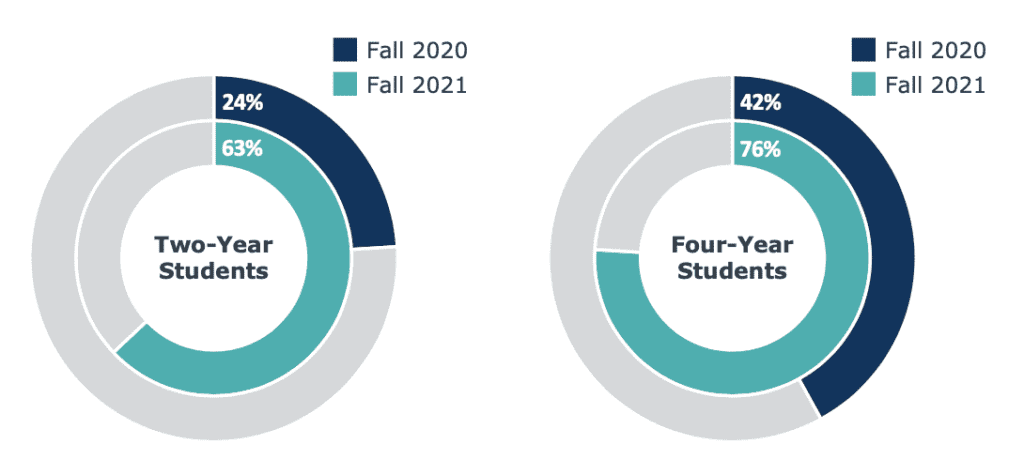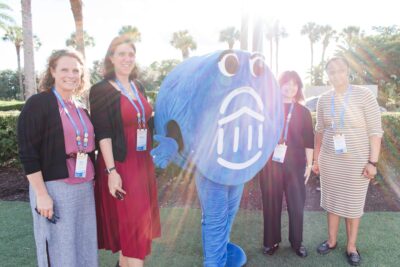What we learned about the future of student success from 1,200 success leaders
CONNECTED is my favorite time of year in the Student Success Collaborative, and this year did not disappoint! I came away feeling energized and with a renewed focus. 1,200 student success leaders convened in Orlando, Florida in November for three days of research presentations, workshops, and spirited networking. Being able to see so many of you in person and have deep discussions about the theme of this year’s conference—building better student experiences for a new tomorrow—was a much-needed boost.
Here are my 3 biggest takeaways from CONNECTED22:
The pandemic is still affecting student success in critical ways
From enrollment declines to widening equity gaps, we are just beginning to come to come to terms with the disruption the pandemic had on our industry. In his keynote address, EAB’s Dr. Ed Venit explored the “ripples” that will impact higher education years into the future, and what actions can be taken today to prepare for them:
1. Disrupted transfer availability
According to the National Student Clearinghouse, higher education is missing 1 in 12 of the students that would have been enrolled had the pandemic not occurred, based on historical trends. This is the third year in a row we’ve seen enrollment declines, with the greatest decline happening at two-year institutions. The lack of upward transfers directly impacts the success of institutions that rely heavily on those transfer students. While the situation can seem grim, the pressure to recruit transfer students could encourage more effective partnerships between two- and four-year schools through solutions such as articulation agreements, transfer pathways, and other collaborative efforts.
2. Elevated student mental health needs
We learned that students mental health may be the greatest threat to retention. Gallup’s State of Higher Education 2022 Report shows the alarming percentage of students who have considered stopping out due to emotional stress—a number that almost tripled from 2020 to 2021 for two-year students.

While things are improving, most students are still not feeling their best—with only 27% saying their mental health is at an all-time high according to the most recent College Pulse Survey. A coordinated effort that allows resources to be funneled towards the students who need it most is crucial to the success of any student mental wellness strategy. Engagement in students’ mental wellness must be elevated to the cabinet level, with some institutions creating roles such as the Chief Wellness Officer to coordinate care efforts.
3. Turnover among success staff
We know student success teams weren’t excluded from the Great Resignation, which led many to leave higher education to explore opportunities with greater flexibility or higher salaries. Whether it be to cope with a limited staff or to simply create more efficient process – many student success teams are looking to technology when improving their student success strategy.
While technology alone will not fix the problems affecting higher education, student success staff armed with the correct technology, like EAB’s Navigate, can work in unison to design support infrastructure that reaches students at the right time.
- Strengthen your early warning system to create coordinated care that cuts down on both time and money for an institution while prioritizing student needs.
- Embrace mass communication to extend your reach and impact on students in a thoughtful but automated way.
- Empower students to utilize self-service tools that point them to immediate answers without overloading your success team.
Compassion is an underrated component of student support
On the second day of CONNECTED22, we heard from Brandon Wolf, an Orlando-based, nationally recognized LGBTQ civil rights advocate, a leader in the movement to end violence in America, and a survivor of the 2016 shooting at Pulse Nightclub. Wolf spoke openly of his experiences growing up in a community that didn’t accept him. After moving to Orlando, he was able to find a true community for the first time, creating a chosen family for himself. As he put it, “Community saved my life.”
His speech kicked off a series of inspirational, TED Talk-style stories from campus leaders about the importance of compassion and empathy in student success work. They emphasized that every institution should be working to create a sense of community on campus, so each student knows that they belong and they have the support they need to continue their education. Several speakers noted that, while leading with compassion may feel like a struggle for already stretched advising staff, it’s more important than ever as staff and students alike deal with the ongoing stress created by the pandemic. Here are some of my favorite quotes from these stories:
Consider your institution’s role in upward mobility for your students
On the final day of the conference, Dr. Raj Chetty, who is the William A. Ackman Professor of Public Economics at Harvard University, shared his research on the equality of opportunity, social mobility, and the prospects of escaping poverty for children. He dismantled the misconception that the United States is a “land of opportunity,” in which a child’s chances of success depend little on their family background—Dr. Chetty’s research on parental income, place effect, and social mobility paint a very different picture. While higher education has always played a crucial role in social mobility in the United States, seeing the realities of college access and social mobility was eye-opening.
Dr. Chetty shared that schools are getting creative when building programs that target specific barriers to access. For example, to help mitigate concerns about cost, the University of Michigan created the HAIL scholarship to provide tuition assistance to students from Michigan public high schools. It’s not only getting students into the school—it’s improving their outcomes once they arrive. The City University of New York created ASAP, a comprehensive Accelerated Study in Associate Program designed to help associate degree-seeking students earn their degrees as quickly as possible, with a goal of graduating at least 50% of students within three years. ASAP works to eliminate these barriers by providing students with the academic, social, and financial support they need to graduate. Campus leaders can visit Opportunity Atlas to see who is lacking opportunities in their community and help develop specific solutions to assist their upward mobility.
Building a new era of student support begins now
To cap off his keynote, Dr. Chetty pointed out a silver lining: throughout history, a lot of opportunities were created through our response to a crisis. While there has been quite a bit of turmoil in the last two and a half years, this time has also given higher education the chance to finally address the long-standing problems that the pandemic only amplified.
CONNEDTED22 gave us both insight and inspiration as we imagine a future for our students. I am excited to see what we have learned take shape in our work, and I look forward to continued conversations and collaboration with our Navigate partners in the year ahead.

More Blogs

EAB Wrapped 2025: A year of reckoning—and reinvention—in higher ed

Four signs it’s time to break up with your student CRM
